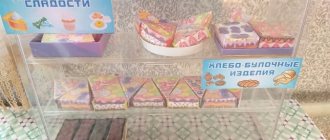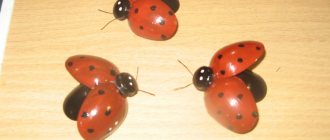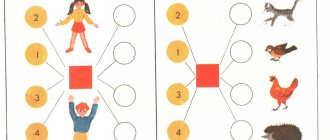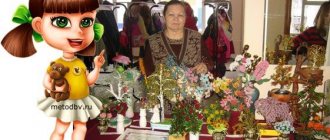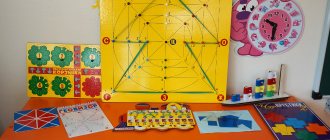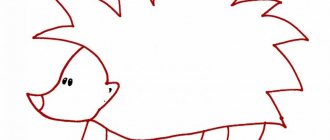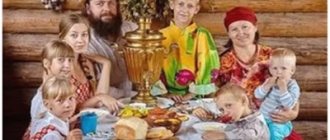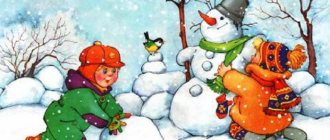DIY math games
Elena Margelova
DIY math games
Game “Collect a fly agaric”
Goal: to consolidate the ability to correlate quantity and number.
Materials : Separate fly agaric caps with different numbers of white dots within 10, and separately fly agaric legs with numbers from 1 to 10.
Description: You can play either individually or as a whole group, taking turns going out and looking for the right hat with the required number of white dots for the leg with the selected number. (children do not see what number the leg will come up with, they are turned upside down, and the child draws to choose from)
Game “Collect a Caterpillar”
Goal: to consolidate knowledge about numbers and their place in the series of natural numbers.
Materials : separate parts of the caterpillar with different numbers within 10.
Description: Each part of the caterpillar is scattered randomly, children collect it in order.
Game “PICK UP THE CLOTHESPICK”
Goal: consolidation of knowledge about the relationship between quantity and number within 10, repetition of the names of geometric shapes, development of fine motor skills.
Materials : drum with sectors in which different geometric shapes are located in different quantities within 10. Clothespins with numbers.
Description: Children are given clothespins with numbers and a tape measure with different numbers of geometric shapes. You can spin the roulette, determining the number of geometric shapes in the drawn sector, name them and find a clothespin with the required number, or you can simply turn the circle over and attach clothespins with the required numbers, while naming the geometric shapes.
Game "FISHING"
Goal: strengthening the skill of solving examples within 10, forming ideas about the composition of numbers within 10.
Materials : cardboard buckets, fish with examples within 10 of addition and subtraction.
Description: You can work individually with one child, he puts the fish in the right buckets, or you can work with a group of children, who will fill the buckets with fish faster and correctly.
Game "GUESS WHICH CHICKEN IS LOST?"
Goal: determine the place of the number in the natural series, name the missing number.
Materials : chicken figures with numbers from 1 to 10.
Description. The chickens are displayed in natural row sequence. Invites the children to look at how they stand, to see if any numbers are missing. After the children guess which chicken is missing, the hidden one is shown and put in its place.
You can use chickens in other tasks, for example: chickens are placed randomly, and children line them up in the correct sequence.
Game “GUESS WHICH IS THE COUNT...”
Goal: to consolidate the skill of ordinal counting.
Description. On a typesetting canvas or on a board, all the heroes of the fairy tale “Turnip”
.Task: “Now we will play the game
“Guess which hero I hid?”
Look how many heroes there are? After listening to the children’s answers, he explains the task: “Try to remember in what order the characters are located. Then I will hide the first hero, and you will tell me which one he was. Who wants to count the heroes in order? The child counts: The first is the grandfather, the second is the woman, etc. Then the children close their eyes, and the teacher removes one hero. The exercise is repeated several times.
Materials and tools for work
In the process of making crafts you will need consumables:
- Paper. Thick cardboard is used as the basis for the craft. Geometric paper shapes are cut from thinner colored sheets.
- Glue. The most suitable option is a glue stick. The chances of getting your hands dirty in this case are minimal. For older children, it is preferable to use liquid PVA glue. In this case, you will need a brush to work, which requires accuracy and patience.
- And for kids, it is better to cook the glue mass from starch. Brew a paste from a tablespoon of starch and 200 g of boiling water. The mixture will not harm babies, even if they swallow it or lick their fingers.
- Additional materials. Beads, buttons, feathers, threads, rhinestones, tinsel, pieces of fabric, trimmings of braid and fur are suitable for decoration.
For some work you will need paints, pencils, and felt-tip pens. In the process of work, it may be necessary to color the elements of the applique or complete the drawing of some elements.
The main tool for creating geometric figures is scissors. The main selection criterion is safety. Requirements for scissors for children's creativity:
- Rounded ends;
- Ease of movement;
- The blades should not be more than 10 cm.
Templates for applique elements can be created using special rulers with stencils.
Important! Before starting work, children need to be told about the rules for safe work with materials and scissors.
It is convenient to construct geometric paper crafts on a special plastic mat. It fits tightly to the tabletop, does not slip, and is easy to wash and clean.
How to organize the process
Applications from geometric shapes do not require artistic abilities from an adult. It is enough to be a creative person. You can select photos of geometric crafts in various manuals or use Internet resources.
The task of the teacher or parents is to select the necessary materials, organize the workplace and ensure safety.
The organization of the process depends on the age of the child.
- Children under 4 years old. For successful work, children can be offered cut-out blanks and shown the sequence of actions. For the first works, it is better to prepare a base with a marked drawing diagram. These should be simple figures. For example, a dish with fruit, an ornament from a sequence of elements.
- Children from 4-5 years old. Basic work skills have already been developed. The process needs to be complicated. Children should learn to work with scissors. Templates with clear contours of the figures are prepared for them. The child’s task is to carefully cut out all the figures, place them on the base according to the pattern, and then glue them. At this age, it will not be possible to cut out an element of complex shape. You need to start with triangles, squares or diamonds.
- Age 6-7 years. Children can create the parts themselves. To work, you can use a ruler with stencils or prepare a template from thick cardboard. Older preschoolers not only prepare the template themselves, but also create a color scheme.
- Junior schoolchildren. Children not only draw figures for applique themselves, but also create and develop a plot, and select a color scheme. This kind of work promotes perseverance, develops accuracy and patience. The work is more complex creatively and technically. Children can do not only appliqué on a plane, but also three-dimensional geometric crafts. For example, flowers with voluminous petals or leaves.
